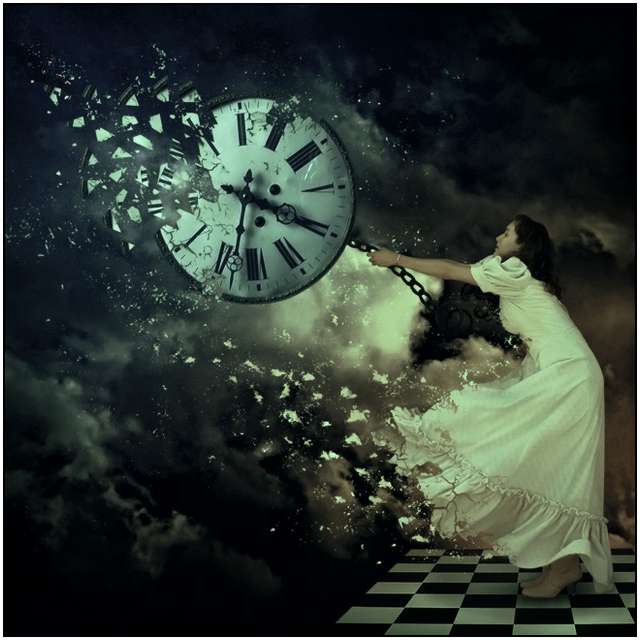 Thick fog this early Sunday here on California’s north coast, especially cold and damp near the ground, and although the NWS calls it ‘patchy fog,’ there’s not much patch in all that gloomy gray.
Thick fog this early Sunday here on California’s north coast, especially cold and damp near the ground, and although the NWS calls it ‘patchy fog,’ there’s not much patch in all that gloomy gray.
Into the smoky-silver fog comes time travel. If I went back exactly 24 hours from this moment, what time would have my laptop clock actually displayed yesterday morning? Same time, minus an hour, of course, but what’s the saving-sanity sense in an outdated, health-detrimental attempt to preserve daylight?
Question the tick-tick of bullshit.
(Illustration: ‘A Break in Reality,’ by Xetobyte, found here).
Non-official official start to summer this morning with the arrival of Daylight Savings Time, where we all leaped an hour ahead. The actual leaping of a laptop’s time device, and along with all radio controlled clocks comes from a tower in the US Midwest:
The radio signals come from a unique radio “station” that doesn’t broadcast any words or music…All the station broadcasts is the time — over and over again — in the form of a special code that only radio-controlled clocks can understand.
In the United States, these time signals are broadcast by a station called WWVB operated by the National Institute of Standards and Technology (NIST) from a base near Fort Collins, Colorado.
The NISI facility’s “primary mission is the dissemination of the standard time interval,” and that’s all within ‘coordinated universal time,’ which is worldwide. There’s an interesting video about the station at USAToday.
DST is one of those institutions that really don’t make sense.
Crack the DST myths at the Washington Post, especially the one on origins of the whole concept being geared toward agriculture, or for the benefit of farmers:
In fact, the inverse is true.
“The farmers were the reason we never had a peacetime daylight saving time until 1966,” Downing told National Geographic.
“They had a powerful lobby and were against it vociferously.”
The lost hour of morning light meant they had to rush to get their crops to market.
Dairy farmers were particularly flummoxed: Cows adjust to schedule shifts rather poorly, apparently.
Daylight saving time, in this or any other country, was never adopted to benefit farmers; it was first proposed by William Willett to the British Parliament in 1907 as a way to take full advantage of the day’s light.
Germany was the first country to implement it, and the United States took up the practice upon entering World War I, hypothetically to save energy.
How did farmers end up being the mythical source of DST?
Downing suggests that because they were such vocal opponents, “they became associated into the popular image of daylight-saving and it got inverted on them. It was just bad luck.”
And not just the farmers…
DST is also not healthy for people already unhealthy, and can sometimes really fuck you up. Some people’s system can’t handle the time shift.
Via LiveScience: ‘In fact, the number of heart attacks increased 24 percent on the Monday following a daylight saving time, compared with the daily average for the weeks surrounding the start of daylight saving time, according to a 2014 study in the journal Open Heart.’
In that regard, this take from cardiovascular expert, Dr Amneet Sandhu, also a fellow at the University of Colorado, Denver, and DST’s impact on the human system (via the Guardian):
Sandhu’s research suggests that hospitals see an increase of up to 25% in the number of patients suffering heart attacks shortly after the clocks go forward in the spring.
Loss of sleep resulting from the mandated time change in the early hours of Sunday morning affects the circadian rhythm and can be risky for those already vulnerable to a heart attack, according to Sandhu.
Sandhu admitted to the Guardian that while he is in rude health himself, he nevertheless dreads the switch to Daylight Saving Time, which he compared to a miniature version of jetlag.
“I never like to lose an hour’s sleep,” he said.
“It’s no fun.”
Sandhu did, however, find it baffling that there appeared to be no definitive research comparing the apparent increase in the incidence of heart attacks shortly after the time change with the offset effect of lighter evenings encouraging more people to exercise and thereby, over a longer period, preventing heart disease.
And…what time is it now?
I’m retired, the time change didn’t bother me at twit’s bit — except the enormous pain-in-the-feeble-ass to re-set the clock mounted on the kitchen wall, which sort of my apartment’s main time device. Even sitting here at the laptop, with its little date/time thingy, I still check the clock over the sink, real time is there.
Upstairs, my bed-side way-old non-RCC clock-radio still has to be reset an hour ahead — what a pisser!